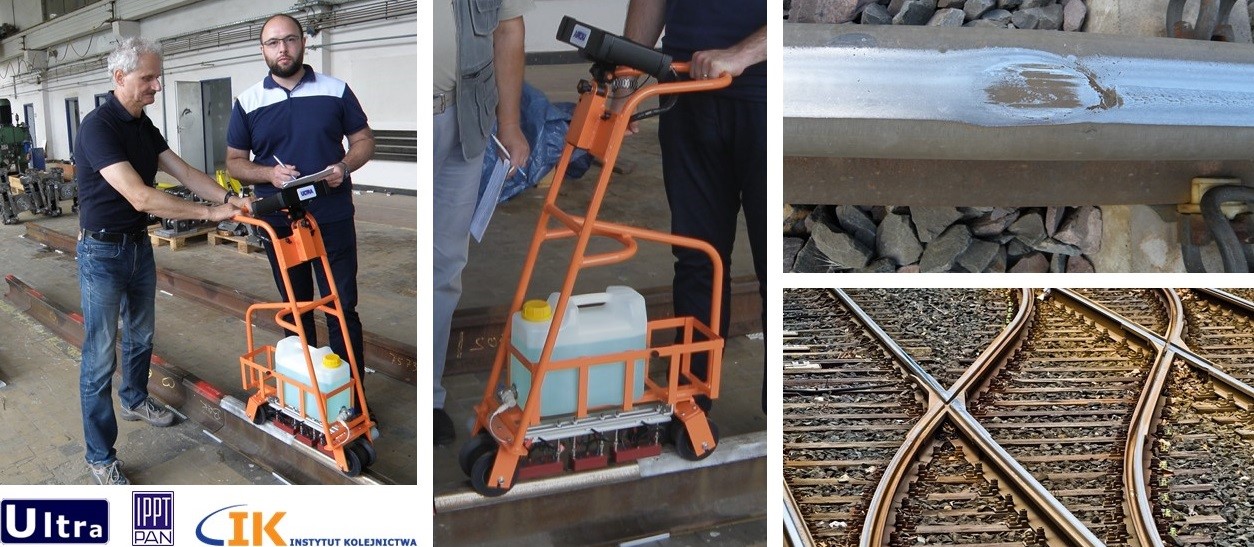Modeling tests performed by IPPT PAN led to the development of a prototype of the computerized diagnostic cart designed to detect interior flaws in rails.
The diagnostic cart, which has been built by the ZBM Ultra SA company, is currently undergoing performance tests on test trucks at the Railway Research Institute. This diagnostic technique is planned to be introduced in the forthcoming years.
Research has been carried out by a consortium of:
- Instytut Kolejnictwa (Railway Research Institute IK – consortium leader),
- IPPT PAN,
- ZBM Ultra SA Company, producer of ultrasound-based defectoscopes (consortium partner).
The IPPT PAN research was conducted by a research team at the Laboratory of Non-Destructive Testing, headed by prof. Zbigniew Ranachowski. The performed research was carried out from 1st October 2020 until 30th September 2021.

Project: “Optymalizacja układu przetworników ultradźwiękowych do wykrywania wad wewnętrznych szyn kolejowych” (Optimization of Ultrasonic Transducer System for the Detection of Internal Flaws in Rails)
Project was commissioned by the PKP Polskie Linie Kolejowe SA (Polish national railway operator) and covered 49% of the total cost, i.e. 879 133 PLN. The total cost of the project, supported by the NCBiR (National Centre for Research and Development) amounted to 2 028 399 PLN.
This research was motivated by the need to modernize the diagnostic apparatus used by the Polskie Linie Kolejowe company. It had thus far been observed that a growing number of trains, together with the introduction of much bigger numbers of speed trains in use, contributed to the emergence of new rail flaws, the so-called contact fatigue flaws in rail heads (as described in many publications, including S. L. Grassie, “Rolling contact fatigue on the British railway system: treatment”, the Wear, 2005; 258 /7-8/, pp.: 1310-1318). Defects of such kinds can further evolve into extensive cracks resulting in the whole rail fracture. Apparatus owned by the Polskie Linie Kolejowe turned out to be ineffective in the diagnosis of such kinds of fatigue flaws and a number of other related flaws, due to the fact that the system of heads used in their apparatus only allowed for generating ultrasonic beams in the central part of the rail head. Such head system does not allow for generating the ultrasonic echoes from vertical cracks, i.e. cracks located close to the transverse plane of the rail head.
Therefore, the task given to the IPPT PAN research team was to design an optimum number of ultrasonic transducers, and model their operating characteristics to allow for implementation in a new apparatus, which, in the subsequent part of the project, was produced by the consortium partner company.
Modeling at IPPT PAN was carried out on the BEAMTOOL9 software developed by Eclipse for a 3-diamentional ultrasonic beam propagating on an object and interacting with the structural flaw. This software uses the so-called Ray-Tracing technique that renders beam propagation according to the principles of geometrical optics. However, applying this method only is insufficient to allow for modeling detections of all types of flaws within the rail material, because in the case of certain defects, all the ultrasonic beams can go from the crack in the direction impossible to reach with the receiver head. To allow for such defects tracing, IPPT PAN designed its original software to calculate echo amplitude reflected in the defects of any given size and plane with the use of diffraction effects on the edges of the defects in question. Software was tested with the IPPT PAN laboratory apparatus and defect models of rail sections. Next, the optimum diagnostic configuration was established for 16 different heads, in order to obtain the diagnostic configuration of the whole rail. Following a series of experiments on real rail fragments, and consultations with the Polskie Linie Kolejowe, the IPPT PAN team produced their recommendations for the configuration of 11 measuring heads that would enable diagnostics of the rail area under the wheels of moving train carriages.
Results of modeling and assessment tests were submitted to the Polskie Linie Kolejowe in two comprehensive reports, and later presented on the 13. International Conference on Structural Materials 2021.















